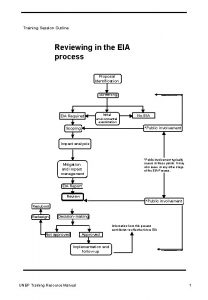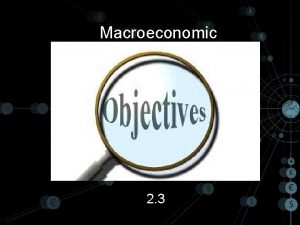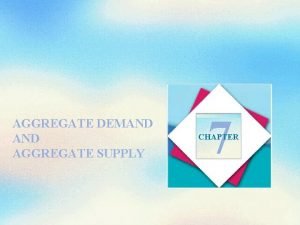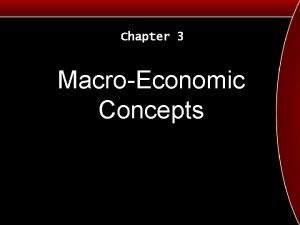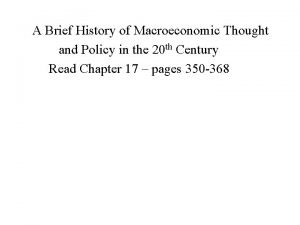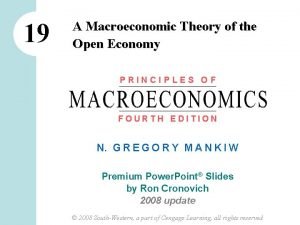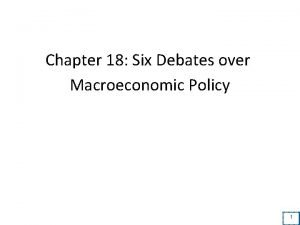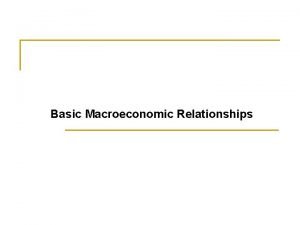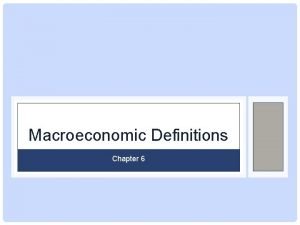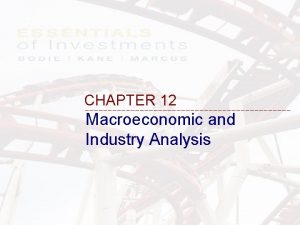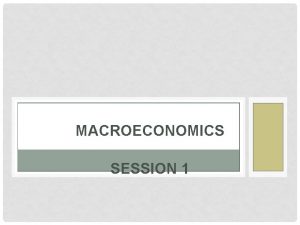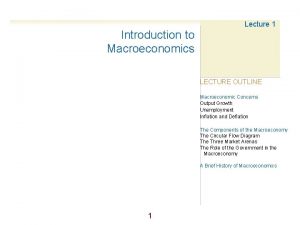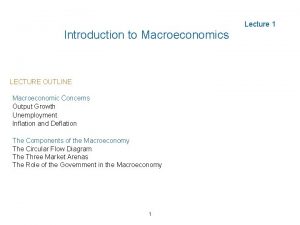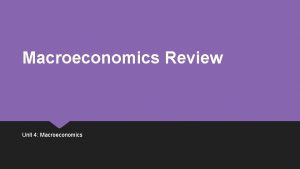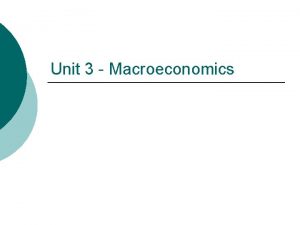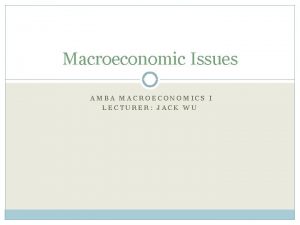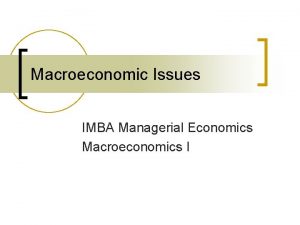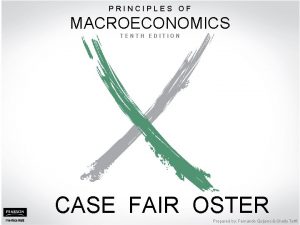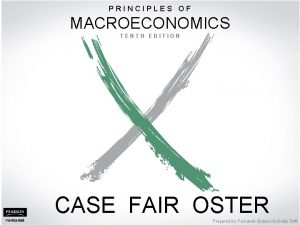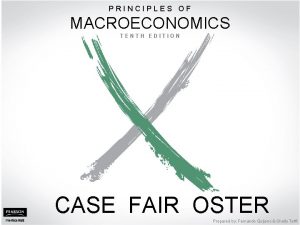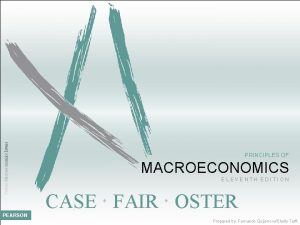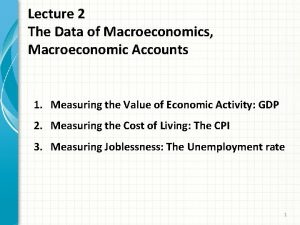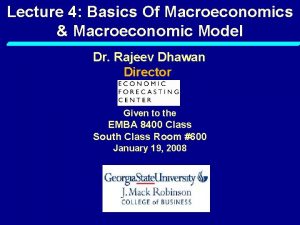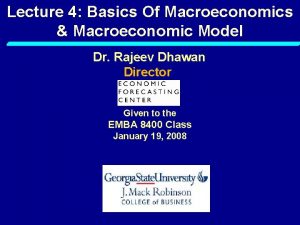MACROECONOMICS SESSION 1 LECTURE OUTLINE Macroeconomic Issues Government


















- Slides: 18

MACROECONOMICS SESSION 1

LECTURE OUTLINE • Macroeconomic Issues • Government in the Macro economy 2

MACROECONOMIC ISSUES Inflation Unemployment Growth Business Cycles 3

MACROECONOMIC ISSUES (CONT(. Inflation can be defined as an increase in the price of a basket of goods and services that is representative of the economy as a whole. Inflation is a continuous and considerable rise in prices in general. Rate of Inflation (t period) =Price level (year t) - Price level (year t -1) X 100 The statistics used to measure changes in the price level are Colombo Consumers’ Price Index (CCPI), Greater Colombo Consumers’ Price Index (GCPI) and Sri Lanka Consumer Price Index (SLCPI) According to the Central Bank of Sri Lanka, the Colombo Consumers’ Price Index (CCPI), which is the official cost of living index in Sri Lanka, recorded an inflation rate of 5. 9 and 6. 9 per cent for the year 2010 and 2011, respectively. 4

INFLATION RATE (CALCULATED IN TERMS OF COLOMBO CONSUMERS’ PRICE INDEX: 2010=100) Inflation, consumer prices (annual %) 30 25 20 15 10 0 -5 1960 1962 1964 1966 1968 1970 1972 1974 1976 1978 1980 1982 1984 1986 1988 1990 1992 1994 1996 1998 2000 2002 2004 2006 2008 2010 2012 2014 5 5

MACROECONOMIC ISSUES Unemployment Rate : The number of unemployed persons as a percentage of the labour force. Unemployed : Persons who are seeking and available for work, but had no employment during the reference period. Unemployment rate = No. of Unemployed X 100 Labor force 6

QUARTERLY REAL DGP GROWTH AND UNEMPLOYMENT 7

GDP GROWTH AND UNEMPLOYMENT 16 14 Unemployment, total (% of total labor force) (national estimate) GDP growth (annual %) 12 10 8 6 4 2 19 85 19 86 19 87 19 88 19 89 19 90 19 91 19 92 19 93 19 94 19 95 19 96 19 97 19 98 19 99 20 00 20 01 20 02 20 03 20 04 20 05 20 06 20 07 20 08 20 09 20 10 20 11 20 12 20 13 20 14 20 15 0 -2 -4 3/12/2021 Department of Business Economics 2014 8

MACROECONOMIC ISSUES Economic growth The growth rate of an economy is the rate at which its gross domestic product (GDP) is increasing. In 2016, Sri Lanka recorded an economic growth rate of 4. 4 per cent (in 2015 it was 4. 8 per cent). The highest GDP growth recorded after independence was 9. 1 per cent in 2012 while the lowest (-1. 5 per cent) was in 2001. An economy can grow overtime as a result of the, • • changes in available amount of resources in the economy; and changes in the efficiency of factors of production. 9

10 0 -2 -4 1960 1962 1964 1966 1968 1970 1972 1974 1976 1978 1980 1982 1984 1986 1988 1990 1992 1994 1996 1998 2000 2002 2004 2006 2008 2010 2012 2014 ANNUAL REAL GDP GROWTH RATE GDP growth (annual %) 8 6 4 2 10

GROWTH RATE, UNEMPLOYMENT RATE, AND INFLATION RATE IN 2015 AND 2016 GDP Growth Unemploym Annual (%) ent (%) Average Inflation (%) 2015 2016 4. 8 4. 4 4. 7 4. 4 2. 2 4. 0 11

MACROECONOMIC ISSUES BUSINESS CYCLE • The term business cycle (or economic cycle) refers to economy-wide fluctuations in production or economic activity over several months or years. • These fluctuations occur around a long-term growth trend, and typically involve shifts over time between periods of relatively rapid economic growth (an expansion or boom), and periods of relative stagnation or decline (a contraction or recession). • Business cycles are usually measured by considering the growth rate of real gross domestic product. • Despite being termed cycles, these fluctuations in economic activity do not follow a mechanical or predictable periodic pattern (is the cycle of short-term ups and downs in the economy). 12

MACROECONOMIC ISSUES Business cycle Inflation, economic growth, and unemployment are interrelated through the business cycle of an economy. Peak Trend Output Peak Recovery Peak Recession Trough Time 13

MACROECONOMIC ISSUES • Policy makers attempt not only to smooth fluctuations in output during a business cycle but also to increase the growth rate of output in the long-run. 3/12/2021 Department of Business Economics 2014 14

GOVERNMENT IN THE MACRO ECONOMY There are three kinds of policy that the government has used to influence the macro economy: 1. Fiscal policy 2. Monetary policy 3. Growth or supply-side policies 15

GOVERNMENT IN THE MACRO ECONOMY (CONT. ) • Fiscal policy refers to government policies concerning taxes and spending. • Monetary policy consists of tools used by the Central Bank to control the quantity of money in the economy. • Growth policies are government policies that focus on stimulating aggregate supply instead of aggregate demand. 3/12/2021 Department of Business Economics 2014 16

INTER-RELATIONSHIP AMONG MACROECONOMIC ISSUES High Inflation Maintain an Appropriate Inflation Rate High Economic Growth High Employment 17

THANK YOU
 01:640:244 lecture notes - lecture 15: plat, idah, farad
01:640:244 lecture notes - lecture 15: plat, idah, farad Training session outline
Training session outline Macroeconomic objectives
Macroeconomic objectives Macroeconomic policy debates
Macroeconomic policy debates Macroeconomic equilibrium occurs:
Macroeconomic equilibrium occurs: Macroeconomic deals withसमग्रलक्षी
Macroeconomic deals withसमग्रलक्षी History of macroeconomic thought
History of macroeconomic thought A macroeconomic theory of the open economy
A macroeconomic theory of the open economy Perdebatan kebijakan makro ekonomi
Perdebatan kebijakan makro ekonomi Six debates over macroeconomic policy
Six debates over macroeconomic policy 5 debates over macroeconomic policy
5 debates over macroeconomic policy Five debates over macroeconomic policy
Five debates over macroeconomic policy Basic macroeconomic relationships
Basic macroeconomic relationships Macroeconomic definitions
Macroeconomic definitions Macroeconomic and industry analysis
Macroeconomic and industry analysis Lecture outline example
Lecture outline example Lecture outline example
Lecture outline example Lecture outline example
Lecture outline example Lecture outline meaning
Lecture outline meaning

